
Brazilian cuisine is the set of cooking practices and traditions of Brazil, and is characterized by European, Amerindian, African, and Asian influences. It varies greatly by region, reflecting the country's mix of native and immigrant populations, and its continental size as well. This has created a national cuisine marked by the preservation of regional differences.

Minas Gerais is one of the 27 federative units of Brazil, being the fourth largest state by area and the second largest in number of inhabitants with a population of 20,539,989 according to the 2022 census. Located in the Southeast Region of the country, it is bordered to south and southwest by São Paulo; Mato Grosso do Sul to the west; Goiás and the Federal District to the northwest; Bahia to the north and northeast; Espírito Santo to the east; and Rio de Janeiro to the southeast. The state's capital and largest city, Belo Horizonte, is a major urban and finance center in Brazil, being the sixth most populous municipality in the country while its metropolitan area ranks as the third largest in Brazil with just over 5.8 million inhabitants, after those of São Paulo and Rio de Janeiro. Minas Gerais' territory is subdivided into 853 municipalities, the largest number among Brazilian states.

Goat cheese, goat's cheese or chèvre is cheese made from goat's milk. Goats were among the first animals to be domesticated for producing food. Goat cheese is made around the world with a variety of recipes, giving many different styles of cheeses, from fresh and soft to aged and hard.

The Brazilian merganser is a South American diving duck in the Mergus genus. It is one of the most threatened waterfowl species in the world, with possibly fewer than 250 birds in the wild and a small number kept in captivity in Brazil. It has a long, sharp-edged beak with a great number of tooth-like edges.
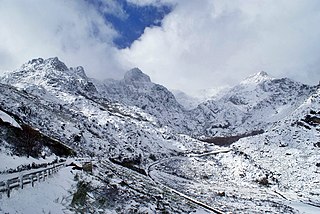
Serra da Estrela is the highest mountain range in Continental Portugal. Together with the Serra da Lousã it is the westernmost constituent range of the Sistema Central and also one of the highest in the system. It includes mainland Portugal's highest point at 1,993 metres above mean sea level. This point is not a distinctive mountain summit, but rather the highest point in a plateau, being known as Torre. Torre is an unusual summit in that it is accessible by a paved road. The peak has a topographic prominence of 1,204 m (3,950 ft) and its parent peak is Pico Almanzor, in Spain.

The oldest known book on Portuguese cuisine, entitled Livro de Cozinha da Infanta D. Maria de Portugal, from the 16th century, describes many popular dishes of meat, fish, poultry and others.

Aiuruoca is a city in the Brazilian state of Minas Gerais. In 2020 its population was estimated to be 5,976.

Minas cheese is a type of cheese that has been traditionally produced in the Brazilian state of Minas Gerais.
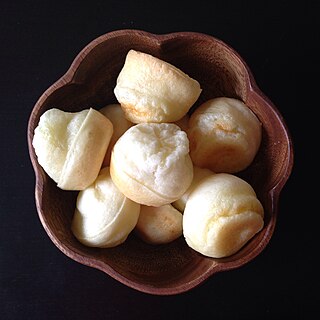
Pão de queijo or Brazilian cheese balls is a small, baked cheese roll or cheese ball, a popular snack and breakfast food in Brazil. It is a traditional Brazilian recipe, originating in the state of Minas Gerais.
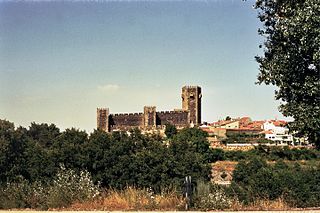
Sabugal is a city and a municipality in the District of Guarda, Portugal. A border municipality with Spain, the population of the municipality in 2011 was 12,544, in an area of 822.70 km2. The city proper, located along the Côa river, has a population of about 3,000 inhabitants. There is a castle in the city of Sabugal proper as well as other castles outside the urban centre in a number of places around the entire municipality of Sabugal. Those are the castles of Sortelha, Alfaiates, Vilar Maior and Vila do Touro. The municipal holiday is the Monday after Octave of Easter. It is also place for the Sabugal Dam built in 2000 and the river beach of Devesa, both located in the Côa river. At an elevation of roughly 750 m (2460 ft) above sea level, Sabugal is among the highest cities in Portugal.
White cheese includes a wide variety of cheese types discovered in different regions, sharing the sole common characteristic of their white hue. The specific type of white cheese can vary significantly depending on the geographical location.

Requeijão is a milk-derived product, produced in Portugal and Brazil. It is a loose, ricotta-like cheese used to make cheese spreads. It can be a good substitute to mild, unsalty ricotta. This variety is sometimes sold in the markets wrapped in fresh corn husks. In El Salvador, cheeses such as requesón can sometimes be transported wrapped in banana leaves instead.

Serra da Estrela cheese is a cheese made in the mountainous region of Serra da Estrela in Portugal. Under the name "Queijo Serra da Estrela" it is a Protected designation of origin (PDO) in the European Union as well as the UK.
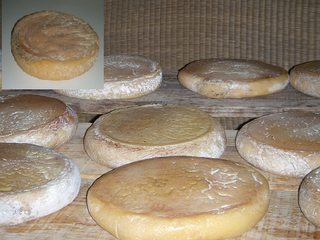
Queso de La Serena is a cheese made from Merino sheep milk in the comarca (district) of La Serena, in Extremadura, Spain. The pure sheep milk is curdled using a coagulant found in the pistils of cardoon. This ingredient lends a light bitterness to the otherwise slightly salty taste. It is aged for at least sixty days. When the cheese has a creamy consistency in the centre, it is traditionally eaten by slicing off the top and scooping out the inside with a spoon, and it is known as Torta de La Serena. If it is allowed to mature further it becomes harder, develops a stronger taste and is known as Queso de La Serena.

São Roque de Minas is a Brazilian municipality located in the west of the state of Minas Gerais. Its population as of 2020 was 7,076 people living in a total area of 2,100 km2. The city belongs to the meso-region of Oeste de Minas and to the micro-region of Piumhi. It became a municipality in 1938.
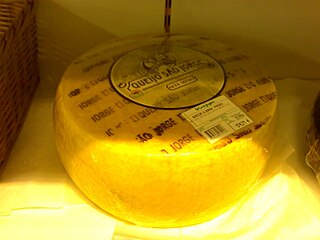
São Jorge Cheese is a semi-hard to hard cheese, produced on the island of São Jorge, in the Portuguese archipelago of the Azores, certified as a Região Demarcada do Queijo de São Jorge and regulated as a registered Denominação de Origem Protegida.
Queijo prato, named after the shape it was originally made by the immigrants, is a Brazilian soft cheese, similar to the Danish cheese danbo. It is one of the most popular Brazilian cheeses.
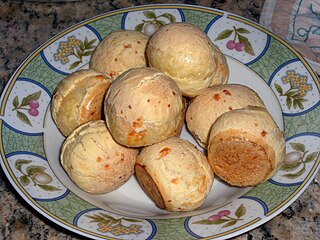
Cheese buns or cheese breads may refer to a variety of small, baked, cheese-flavored rolls, a popular snack and breakfast food in Brazil. Cheese buns may be made with cassava and or corn starch, and cheese. In countries where the snack is popular, it is inexpensive and often sold from street vendors, bakeries, in snack shops, and in grocery stores.

Romeu e Julieta is a traditional Brazilian dessert made of cheese and goiabada. While the most simplistic form of this dessert consists of goiabada over a slice of cheese, desserts and foods can be prepared into Romeu e Julieta versions of themselves by incorporating goiabada and cheese into the recipe. The dessert's name is a reference to the title romantic couple of the Shakespearean classic Romeo and Juliet with cheese representing Romeu and goiabada representing Julieta.

The Serra da Estrela is a Portuguese breed of domestic sheep. It originates in the Serra da Estrela range of mountains in the Beiras e Serra da Estrela sub-region of east-central Portugal, and is distributed mainly in that area.


















